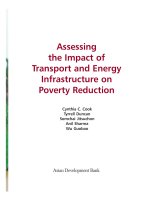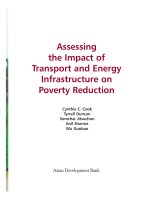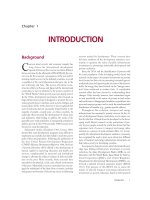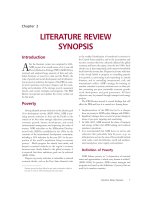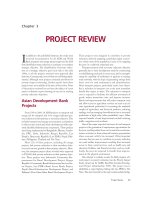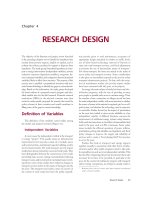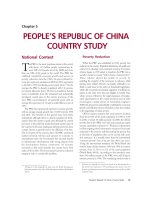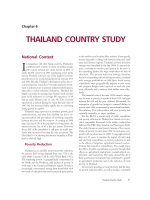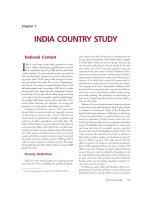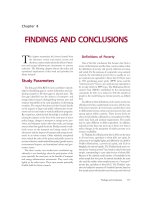The impact of repetition and recycling on grade 11 students vocabulary retention at long hai phuoc tinh high school
Bạn đang xem bản rút gọn của tài liệu. Xem và tải ngay bản đầy đủ của tài liệu tại đây (691.53 KB, 12 trang )
VIETNAM NATIONAL UNIVERSITY, HANOI
UNIVERSITY OF LANGUAGES AND INTERNATIONAL STUDIES
FACULTY OF POST- GRADUATE STUDIES
****************************************
PHÙNG THỊ LAM
THE IMPACT OF REPETITION AND RECYCLING ON
GRADE 11 STUDENTS’ VOCABULARY RETENTION
IN LONG HAI – PHUOC TINH HIGH SCHOOL
(TÁC ĐỘNG CỦA VIỆC LUYỆN TẬP CỦNG CỐ
ĐỐI VỚI SỰ GHI NHỚ TỪ VỰNG CỦA HỌC SINH LỚP 11
Ở TRƯỜNG THPT LONG HẢI – PHƯỚC TỈNH )
MINOR M.A THESIS
Field: English Teaching Methodology
Code: 60 14 10
HÀ NỘI, 2011
VIETNAM NATIONAL UNIVERSITY, HANOI
UNIVERSITY OF LANGUAGES AND INTERNATIONAL STUDIES
FACULTY OF POST- GRADUATE STUDIES
****************************************
PHÙNG THỊ LAM
THE IMPACT OF REPETITION AND RECYCLING ON
GRADE 11 STUDENTS’ VOCABULARY RETENTION
IN LONG HAI – PHUOC TINH HIGH SCHOOL
(TÁC ĐỘNG CỦA VIỆC LUYỆN TẬP CỦNG CỐ
ĐỐI VỚI SỰ GHI NHỚ TỪ VỰNG CỦA HỌC SINH LỚP 11
Ở TRƯỜNG THPT LONG HẢI – PHƯỚC TỈNH )
MINOR M.A THESIS
Field: English Teaching Methodology
Code: 60 14 10
Supervisor: ĐỖ BÁ QUÝ, M.A
HÀ NỘI, 2011
iv
TABLE OF CONTENTS
Certificate of originality……………..………………………………………………………i
Acknowledgements ……...…………………………………………………………………ii
Abstract……………………………………...……………………………………………..iii
Table of content ……………………………………………………………………………iv
List of abbreviations ………………………………………………………………………..v
PART A – INTRODUCTION ............................................................................................. 1
1. Rationale ............................................................................................................................ 1
2. Aims of the study ............................................................................................................... 2
3. Scope of the study .............................................................................................................. 2
4. Research hypotheses and questions ................................................................................... 3
5. Method of the study ........................................................................................................... 3
6. Organization of the study ................................................................................................... 3
PART B – DEVELOPMENT............................................................................................ 54
CHAPTER I: LITERATURE REVIEW ........................................................................... 5
1 Teaching and Learning Vocabulary .................................................................................... 5
1.1 What is Vocabulary? ........................................................................................................ 5
1.1.1 Receptive and Expressive Vocabulary .................................................................. 5
1.1.2 Active and passive vocabulary .............................................................................. 6
1.2 The importance of vocabulary in second language learning ........................................... 6
1.3 What is involved in knowing a word .............................................................................. 7
1.3.1 Form ...................................................................................................................... 7
1.3.2 Meaning ................................................................................................................ 7
1.3.3 Grammar ............................................................................................................... 8
1.3.4 Collocation ............................................................................................................ 8
2. Factors affecting the retention of vocabulary. ................................................................... 8
2.1 Memory and storage system ............................................................................................ 8
2.1.1 The Keyword Method ......................................................................................... 10
2.1.2 The Visual Aids on Vocabulary Learning .......................................................... 10
2.1.3 The Semantic Mapping on Vocabulary Learning ............................................... 10
2.2 Frequency of meeting .................................................................................................... 11
v
2.3 Quality of Processing ..................................................................................................... 11
3. Other factors .................................................................................................................... 11
3.1 Learning styles ........................................................................................................ 11
3.2 Teaching method...................................................................................................... 12
4. Repetition and Recycling in Language learning ............................................................. 12
4.1. The spacing of repetition ........................................................................................ 13
4.2. Testing and the Retrieval Practice Effect ............................................................... 14
5. A review of similar studies ............................................................................................. 14
CHAPTER 2 – METHODOLOGY…………………………………………………….15
1.The setting of study........................................................................................................... 16
1.1. Context of Study ...................................................................................................... 16
1.2. Why quasi – experimental research ......................................................................... 17
2. Participants of the study ................................................................................................... 18
2.1 Participants .............................................................................................................. 18
2.2 Sampling ................................................................................................................... 18
3. Materials .......................................................................................................................... 19
3.1 The course book ....................................................................................................... 19
3.2 The course content ..................................................................................................... 19
3.3 What are relevant activities? ...................................................................................... 19
4. Data collection instruments .............................................................................................................. 21
4.1 T –Test ...................................................................................................................... 21
4.1.1 The purpose of the test .......................................................................................... 21
4.1.2.What to test ........................................................................................................... 22
4.1.3. Test....................................................................................................................... 22
4.2. Questionnaires ............................................................................................................ 22
4.2.1.Questionnaires for students .................................................................................... 22
4.2.1.1.The pre-treatment questionnaire ....................................................................... 23
4.2.1.2.The post-treatment questionnaire...................................................................... 23
4.2.2.Questionnaires for teachers ..................................................................................... 23
5. Procedure of data collection ............................................................................................ 23
5.1. Schedules ...................................................................................................................... 24
5.2. Treatment ...................................................................................................................... 24
vi
5.3. Data collecting and processing procedures ................................................................... 25
CHAPTER 3 - DATA ANALYSIS AND FINDINGS ..................................................... 26
3.1 Results of the T – Test ................................................................................................... 26
3.2 The result of pre-test scores of the two groups .............................................................. 26
3.3. The result of post-test scores of the two groups ........................................................... 28
3.4 Summary of the test scores of the two groups in the pretest and posttest ..................... 32
3.5 Survey results ................................................................................................................ 33
3.5.1. The pre-treatment questionnaire for students ......................................................... 33
3.5.2. The Post-treatment Questionnaire for students ....................................................... 34
3.5.2. Questionnaire for teachers ...................................................................................... 34
PART C. CONCLUSION................................................................................................. 38
1. Findings and conclusion .................................................................................................. 38
2. Pedagogical Implications ................................................................................................. 40
3. Limitations of the study ................................................................................................... 41
4. Suggestions for further studies ........................................................................................ 41
REFERENCES…………………………………………………………………………..42
APPENDIX………………………………………………………………………………..I
1
PART A – INTRODUCTION
1. Rationale
Given its importance to learning, vocabulary has been a prominent concern of many
theorists and researchers in the field.
In learning English, however, the greatest challenge is likely retaining the words.
Researchers and teachers now have been drawn to the concern of how to make students
enhance vocabulary retention for communicative value. Studies have shown that practising
things makes us better in learning a language and develops automaticity. In other words,
language learning proceeds gradually through repeated exposure and practice. The course
book English 11 (published by Educational Press), however, does not deal with it sufficiently.
Many students now suffer from considerable difficulties in retaining previously
encountered English words. They struggle to maintain retention. But not many of them are
capable of it. This matter of fact leads to their poor production both in speaking and writing.
2. Aims of the study
The aim of this study is to investigate the impact of repetition and recycling on vocabulary
learning and retention, or to put it differently, the extent to which short tailored activities helps
to retain vocabulary for the students at Long Hai – Phuoc Tinh High school and some
pedagogical implications.
3. Scope of the study
In the current study, the author set the limit of investigating possibly – applied activities
that can be carried out at beginning or in the middle of 45-minute periods in such large-sized
classes at Long Hai – Phuoc Tinh High school, vung Tau. The activities were related to first
three units (which equal to 18 lessons) of the course book English 11.
4. Research hypotheses and questions
The study is to get the answers to the following questions:
1) To what extent do EFL teachers encourage repetition and recycling vocabulary among
their students?
2) What is the effectiveness of using repetitive and recycling focused activities on enhancing
11th - graders’ vocabulary retention?
2
3) What are the students’ attitudes towards using activities in teaching and learning
vocabulary?
5. Method of the study
The study is a quasi-experimental design involving the three components of experiments:
the population (the 11th grade students at Long Hai – Phuoc Tinh high school, Ba Ria Vung
Tau), the treatment (repetitive and recycling focused activities), and the measurement of the
treatment (T-test).
- Questionnaires were delivered to teachers to investigate the ways they encourage repetition
and recycling vocabulary among students.
- Questionnaires were delivered to the subjects before treatment to get to know their own
strategies of memorizing vocabulary.
- Questionnaire s were delivered to the subjects after treatment as a supporting tool to obtain
their attitude towards the technique applied.
- Observation was also employed during the teaching time to recognize the participation of
students in the control group and the experimental group.
6. Organization of the study
This thesis is organized around three parts:
Part A is the introduction which presents the rationale for the research topic, aims of study,
scope of study, research hypotheses and questions, and method of the study.
Part B is the development which consists of three chapters.
- Chapter one reviews scholarly theoretical background to teaching and learning vocabulary in
a second language.
- Chapter two deals with the methodology of this research in terms of the setting of the study,
sampling participants, instruments and procedure of data collection.
- Chapter three devotes to the account of the study in terms of data analysis and findings
interpreted from the results of the T-test and questionnaires.
Part C is the conclusion which discusses the major findings and limitations of the research,
then suggests teaching implications and proposes some suggestions for further research.
3
PART B - DEVELOPMENT
CHAPTER I: LITERATURE REVIEW
1 Teaching and Learning Vocabulary
1.1 What is Vocabulary?
1.1.1
Receptive and Expressive Vocabulary
1.1.2 Active and passive vocabulary
1.2 The importance of vocabulary in second language learning
1.3 What is involved in knowing a word
1.3.1 Form
1.3.2 Meaning
1.3.3 Grammar
1.3.4 Collocation
2. Factors affecting the retention of vocabulary.
2.1 Memory and storage system
2.1.1 The Keyword Method
2.1.2 The Visual Aids on Vocabulary Learning
2.1.3 The Semantic Mapping on Vocabulary Learning
2.2 Frequency of meeting
2.3 Quality of processing
3. Other factors
3. 1 Learning styles
3. 2 Teaching method
4. Repetition and Recycling in Language learning
4.1. The spacing of repetition
4.2. Testing and the Retrieval Practice Effect
5. A review of similar studies
CHAPTER 2 – METHODOLOGY
1.The setting of study
1.1 Context of Study
4
Long Hai – Phuoc Tinh high school is a state-run school located in Long Hai town in Ba
Ria – Vung Tau. The school has a modest educational staff of 71 people who provide
education to 1425 students. The EFL group consists of 9 teachers.
The typical setting of instruction is three 45-minute –long periods of English a week.
Due to the limited time in a correspondence to a wide range of words to teach and
students’ low English proficiency, EFL teachers at Long Hai _ Phuoc Tinh high school often teach
vocabulary in the traditional teacher-centered method. The teachers normally dominate class to explain
words by words. They often employ three following steps in teaching vocabulary. First, teachers have
students read the passage. After that, new words are raised and elicited through some games, word
maps, or simple presentations. Then students try to get Vietnamese equivalents of the words and read
them aloud once or twice. To help students practice the vocabulary, the teachers have them do some
kinds of exercises such as: gap filling, word matching, definitions matching, etc.. available in the
course book.
1.2 Why quasi – experimental research
As this study was conducted on the students in two already existing classes which were
assigned by the high school where the researcher was working, a quasi-experimental method
was naturally chosen.
1.
Participants of the study
2.1 Participants
The population of the study were 84 ESL students coming from two classes in Long HaiPhuoc Tinh high school in BR-VT. Most of them were born in 1995 and have studied English
as a Foreign Language for five years or more. Results of the pre-test showed that their English
vocabulary competence differed little. All in all, these two groups had a lot of common
features in terms of number, gender, English level as well as motivation to learn. Moreover,
these students’ characteristics were typical of the 11th grade non-major students at Long HaiPhuoc Tinh high school.
2.2 Sampling
In the study the researcher adopted the systematic sampling as a strategy to select subjects
from a population list in a systematic. Specifically, with the required number of 56 out of the
population of 84, the simple statistic should be use:
f=N÷ Sn
5
f = frequency interval
N = the total number of the wider population
Sn = the required number in the sample
Hence the frequency interval (f) is
84÷56 = 1.5
As a result, the researcher omitted every third name on the list of cases.
3.Materials
3.1 The course book
The English 11 is designed basing on the basic principles of Communicative Language
Teaching. However, the course book do not include sufficient communicative activities for
practice. This demands more work on the part of the teacher in selecting appropriate activities
to attract students.
3.2 The course content
As being stated above, due to the limitation of time and application, the study only deals
with three units among sixteen ones appearing in the current course book English 11, namely
unit 1 “Friendship”, unit 2 “Personal Experience”, and unit 3 “A Party”.
3.3 What are relevant activities?
- Activities that involve brief reading, repetition, making sentences, listing words and so on
are supposed to be relevant to provide background for practicing certain chunks or for
recycling vocabulary, thus aid language processing and ultimately vocabulary retention.
- When designing some extra activities, the researcher took into account all the conditions of
the participants and based on the Taxonomy of Vocabulary Learning Strategies which is
adopted from Schmitt 1997:207.
4. Data collection instruments
4.1 T -Test
The pre-test and post–test employed in the study were designed to measure the effect of
repetitive and recycling-focused activities on students’ ability to retain vocabulary.
4.1.1 The purpose of the test
- The pre-test was given to the two groups in the same week with the primary purpose of
measuring students’ vocabulary size and their level of vocabulary retention.
- The post-test was implemented to assess how effective the tailored activities utilized were. .
6
4.1.2 What to test
The pre-test served as a means to measure students’ vocabulary size and their level of
vocabulary retention. The target words in the pre-test were drawn from the word list of the
course book English 10 ( from unit 9 to unit 16 inclusively) whereas ones in the progress test
came from the glossary of three units of the course book and a number of words added by the
teacher on assumption of they are unfamiliar to the students.
4.1.3 Test
In the study, the test comprised five different types of exercises in the form of an
objective test. Here in this paper, the test frame included multiple choice, gap-filling, matching
and word – formation.
4.2 Questionnaires
4.2.1 Questionnaires for students
4.2.1.1 The pre-treatment questionnaire
On completing the study, 20 random subjects in the two groups were sampled out of the 56,
A questionnaire listed 15 memory strategies was used in the survey.
4.2.1.2 The post-treatment questionnaire
The post- treatment questionnaire was administered to get students’ feedback about the
treatment. It was a brief questionnaire with 5 questions.
4.2.2 Questionnaires for teachers
The aim of the questionnaire for teachers was to find out teachers' attitude towards
enhancing vocabulary retention and approaches they use. The questionnaire contains 10
questions where 3 questions require only yes and no responses.
Tải bản FULL (18 trang): />Dự phòng: fb.com/TaiHo123doc.net
5.
Procedure of data collection
The practice of study involves the systematic collection of information about the subjects,
activities, and outcomes of the experiment measuring the impact of repetition and recycling on
students’ vocabulary retention. This is a experimentally quantitative research involving a trial
in which the subjects (n=56) are measured before and after treatment with T-test.
5.1 Schedules
7
The study was carried out within 6 weeks of the first semester in 2 classes. Each class
work with English of 3 forty-five minute periods a week. So, the schedules were designed
upon 18 periods. The detailed schedule of supplemental activities for both class was in the
appendix 2.
5.2 Treatment
In the first stage, the participants were asked to take a vocabulary pretest. Then a brief
questionnaire is delivered.
In the class hours, both control and experimental group received the usual instruction and
exercises based on the course book. Words and structures were presented to them in a same
traditional manner. Regularly at the beginning of each class, the experimental group joined a
variety of activities designed by the teacher focusing on the production and recycling of the
words that they have learnt before. Six weeks later, students were unexpectedly given a posttest. The result of the test, then, was drawn out to be compared with the prior test. A follow-up
questionnaire was then administered to investigate students perceptions and attitudes toward
vocabulary learning.
5.3 Data collecting and processing procedures
The following steps were carried out to collect the results from the pretest and the posttest.
Step 1: Doing and marking the pre-test. All test - takers sat at the tests on the same day
under the serious control of the teacher (who is also the researcher). The pre-test took place on
16th August, 2011 and the marking process was seriously carried out right after the tests.
Step 2: Conducting a brief minor questionnaire to explore students’ preferred strategies to
memorize vocabulary.
Step 3: Doing and marking the post-test. The post-test took place on 24th September, 2011
and the marking process was seriously carried out right after the tests.
Step 4: Administering another questionnaire to investigate subjects’ attitude towards
techniques applied.
Step 5: Synthesizing the results of the pretest and posttest for later analysis and
comparisons.
Step 6: Using the SPSS software version 16.0 as a tool to analyze the results of the tests.
CHAPTER 3 - DATA ANALYSIS AND FINDINGS
6813874
